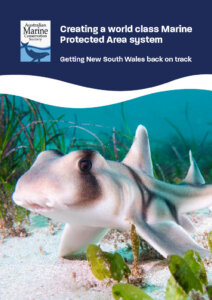Authored by Professor David J Booth and Giglia Beretta. Report prepared for the Australian Marine Conservation Society.

Executive Summary
NSW enjoys a biodiverse coastal marine environment which supports a unique mix of tropical and temperate species.
The NSW Government has an opportunity to better protect this biodiversity by correcting past neglect of the NSW Marine Protected Area (MPA) system and returning NSW to its world class reserve system. The report begins by setting out a strong science case for the importance and value of the NSW MPA network, then discusses flaws in NSW’s MPA planning process and makes recommendations for the future.
In 2013 and 2019, the NSW Government downgraded 36 sanctuary zones (SZs) across the NSW MPA system. These downgrades set a dangerous precedent where best-practice and scientific input were not fully employed. We argue that restoration, retention, and expansion of SZs are critical — they are key to local maintenance of biodiversity and fish populations, and essential longshore pathway stops for fish dispersal.
This report will detail the evidence that SZs are key biodiversity safeguards and of additional benefit to adjacent fisheries (commercial and recreational), and so removing them is a threat to the NSW’s marine environment. Apart from local value, SZs act as “stepping stones” for larval and adult longshore connectivity, so removals may disrupt this process. SZs have been conclusively shown to enhance biodiversity especially of fishes, particularly exploited fishes (which are often very important in food webs). SZs are also of social and economic value, including places where swimmers, divers, snorkelers, tourists visitors can enjoy a high quality marine environment.
We share key recommendations to assist government efforts to create a world class MPA reserve system. These will ensure marine parks (especially SZs) are well supported to give maximum biodiversity benefit, providing additional enhancement to recreational user value, including for fishing, tourism, and general nature appreciation. We recommend a process be in place to prevent non-scientific removal of SZs, as has happened previously, as well as supporting adequate enforcement and scientific performance-testing of their values.